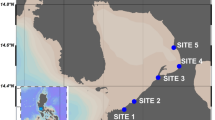Abstract
In an experiment, which lasted nine months, real sea bed sections and naturally occurring sediment dwelling organisms have been used to study the decomposition of today’s “green” chemicals, i.e. drilling mud chemicals comprising α-olefins or esters made from fatty acid extracted from fish. Both types have been shown to be degraded at aerobic conditions at sea bed. However, the fate of the alcoholic part of the ester has been unknown, as was the rate of degradation of the olefin. Both olefin and alcohol were labelled with 14C at the C1 atom. The results show that the ester hydrolyses quickly and after a lag phase the alcohol is oxidised, while the olefin degrades more slowly. 133Ba-labelled baryte was used as a bioturbidity marker. The measurements, i.e. scanned sediment columns, show very little bioturbation in the boxes where oil-contaminated sediment was present whereas the control boxes showed more activity from the sediment dwelling organisms down to the depth of the contaminated layer.
Similar content being viewed by others
References
Degouy D., Argillier J.-F., Demoulin A., and Velghe F.: in Proc. Offshore Europe 93 (1993) 507–514.
Schaanning M. T., Hylland K., Lichtenhaler R., and Rygg B.: NIVA-O-3475/96 (1996).
Peresich R. L., Burrell B. R., and Prentice G. M.: in Proc. Drill Conf. Amsterdam, NL, 21935 (1991) 333–340.
Rabion A., Perie F., Basseres A., Guillerme M., and Zurdo C.: in Proc. 1997 SPE/UKOOA European Envir. Conf., Aberdeen, UK, (1997) 215–221.
Wittig, A. and Vogel, A.: Practical Organic Chemistry, Longman, London 1978, 337 and ref. cited therein.
March J.: Advanced Organic Chemistry: reactions, mechanism and structure, Wiley, New York, 1992, 956 and ref. cited therein.
Gaylord: Reduction with Complex Metal Hydrides, Wiley, New York, 1956, 795.
March J.: Advanced Organic Chemistry: reactions, mechanism and structure, Wiley, New York, 1992, 392 and ref. cited therein.
Eriksen D.Ö: in Annual report 1994, Strategic Technology Project, IFE Tracer Technology, IFE/KR/F-95/016.
Molvæer J., Knutzen J., Magnusson J., Rygg B., Skei J. and Sørensen J.: SFT Veiledning 97:03. TA-1467/1997, 36 pp. (1997).
Blanchet D., Audibert A. and Argillier J.-F.: in Proc. IADC/SPE Asia Pacific Drilling Tech. Conf. (1998).
Candler J. E., Lee B., Rabke S. P. Geliff J. M., Stauffer R. and Hein J.: SPE 61203 (2000)
Author information
Authors and Affiliations
Additional information
Acknowledgement. The authors like to acknowledge supports from The Norwegian Research Council and the Norwegian Petroleum Directorate, BP Services SA, Belgium, and The Norwegian Institute for Water Research. We also like to thank the Department of Chemistry, University of Oslo for use of facilities during synthesis of the radioactive compounds.
Rights and permissions
About this article
Cite this article
Eriksen, D.Ö., Songe, P. & Schaanning, M.T. The degradation of 14C-labelled drilling chemicals in a simulated seabed study. Czech J Phys 53 (Suppl 1), A119–A125 (2003). https://doi.org/10.1007/s10582-003-0018-7
Issue Date:
DOI: https://doi.org/10.1007/s10582-003-0018-7




